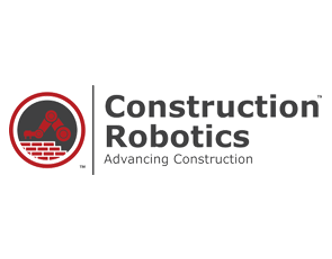
The slow adoption of robotics in Construction
Back in 1987, Japanese academics, robot manufacturers and contractors were already working on the first documented research about automated construction processes. Since then, construction robotics never stopped improving. ‘Robotics’ refers to the use of machines that have an automated component: construction robots are designed to help and assist humans in their day-to-day work on construction sites. The most common construction robots are stand-alone, fixed machines used for repetitive and precise applications (e.g. articulated arms). Then, there are collaborative robots (or cobots) that directly interact with human workers and perform a specific task – such as lifting heavy loads. A third type of robots are exoskeletons which are connected to the human body to support them in difficult tasks (e.g. for heavy-duty). Finally, the autonomous guided vehicles and autonomous mobile robots can navigate either onboard (e.g. camera or laser based) or in external environments (e.g. drones).
A good example of cobot is SAM (Semi-Automated Mason), the bricklaying robot designed by Construction Robotics. SAM works alongside the mason and assists him/her with the repetitive and arduous lifting and placing of bricks. The mason remains in charge of the setup and responsible for final quality. SAMs can lay 250 to 300 bricks per hour, improving by up to 4 times the number of bricks than a man could lay when working alone. With a retail price of $500,000, the firm that SAMs users can expect an ROI within three years, thanks to a reduction of labor costs by at least 30%, low maintenance costs and an expected lifespan of about 10 years.
Construction Robotics are not the only ones coming with an attractive value proposition for construction firms. Robotics companies and start-ups put forward financial benefits, productivity gain and safety as the main commercial arguments. Indeed, labor costs usually represent between 20% and 50% of a construction project total cost – and 38% of it could be automated according to a McKinsey study, leading to a potential cost saving of 20%. Although the initial investment is high, robotics firms claim that in the long-term, it is more cost-effective to purchase robots: in the United States, the average robot cost (including maintenance) is 4 times lower than labor wage stated McKinsey. Moreover, robotics is a guarantee of accuracy. Its work is extremely precise and predictable, thus meeting deadlines and avoiding delay expenses is easier. Another advantage of robotics is the minimization of injuries and providing a safer workplace. For instance, autonomous vehicles can operate independently in hazardous areas.
However, robotics in construction is still not widely adopted and there is under-automated when compared to other manufacturing industries. The construction industry has been classified by McKinsey as « in middle range for automation ». There are several reasons for slow adoption rate of robotics in this industry:
- The complexity of construction sites – unique end-product, unpredictable weather – leads to non-repetitive tasks and involving judgement
- The unpredictable and ever-changing environment: the flexibility required for construction works is for still difficult to automate. As previously said, only 38% of the time spent on unpredictable physical work in construction could be automated with current technologies compared to a 70% for predictable physical work (e.g. in automotive).
- The need for technology to improve: although there are plenty of promising innovations, improvements of the current technology are needed in the adaptability to real-time variability. Moreover, on construction sites there are hundreds of tasks and multiple phases. As there is no multitask-programmed robot, many construction firms remain reluctant to integrate robots to their regular activities.
- The significant investment costs: Investing in robotics involves high initial capital investment, including R&D. Although in the long term it is said to be beneficial, it remains an obstacle for many companies.
- Legal and safety issues: even though robots should reduce the risks on construction sites, the appropriate allocation of risk is a concern for all the construction participants. There is a need specific regulation in the use of robotics on sites. This issue is starting to be addressed (e.g. the compulsory use of Building Information Models in UK since 2019). The cyber risk also needs to be considered.
- Jobs implications: If 40% of current construction jobs would be “at high risk” of automation by the 2030s, according to a 2018 PwC study, the transition will take some time and the major challenge for workers will be to not be replaced by robots but to learn to work side by side with them. A specificity of the construction industry is the importance of craftsmanship, that adds value to projects. Replacing all human workers by robots would mean taking away the quality-assessment aspect that current robots cannot provide. Thus, collaborative robots may be the most appropriate solution as they are designed to work alongside human counterparts instead of entirely replacing them. Cobots will contribute to improve productivity by carrying out tasks that would otherwise be considered busywork or for employees.
The current labor-shortage in construction – A 2019 survey by Associated General Contractors of America and AutoDesk reported that 80% of firms find it difficult to hire labor force – will surely weight into the scale of construction robotics rise. Thanks to 5G and other technology improvements, better connectivity will make it easier for multiple robots to co-operate and better understand the environment they are operating in. Compared to other heavy industries, job automation in construction is rather low but it is poised to increase faster than them in the coming decades. According to a PwC study, in the late 2020s, job automation potential in construction is 16% versus 19% on average for all industry sectors but the automation potential for construction in the mid-2030s is forecast to be 39% versus 30% for all sectors.
2 Key Figures
77 construction robotics startups
in the world, according to a Tracxn query.
Market size expected to reach $460M by 2026
According to Verified Market Research, the global Construction Robotics market size was valued at $212 Million in 2019 and is expected to reach $460 Million by 2026.
3 startups to draw inspiration from
This week, we identified three startups that we can draw inspiration from: Construction Robotics, Kewazo and SuitX.

Construction Robotics
New-York based company, Construction Robotics is dedicated to developing affordable, leading-edge robotics and automation equipment for the construction industry.

Kewazo
Based in Munich, Kewazo develops smart robotic elevators for industrial and construction sites with focus on scaffolding. Kewazo solutions intend to improve construction logistics via data analysis and robotics.

SuitX
The US-based startup SuitX builds a robotic exoskeleton for medical and industrial markets, designed to reduce the amount of strain on the knees and quadriceps.
123Fab #13
1 topic, 2 key figures, 3 startups to draw inspiration from

Is Hydrogen the fuel of the future?
Electromobility is a crucial topic these days, resulting from the need to tackle climate change and Battery Electric Vehicles (BEV) are receiving a lot of attention, boosted by the rise of Tesla and Elon Musk’s popularity. But the adoption of BEV is limited by battery technologies: uncertainty about battery life and charging times, the imbalance of electric grids and the shortage of raw materials — such as lithium which is a scarce material – are challenging the rise of BEV.
Another type of Electric Vehicle is catching up, using compressed hydrogen gas to generate electricity and power electric motors, called Fuel Cell Electric Vehicles (FCEV). The key difference with Battery Electric Vehicles is that FCEV are not powered by a battery that needs to be charged from an external power source. Indeed, hydrogen vehicles can produce their own electric power by filling up the fuel cell with hydrogen. Then occurs a chemical process of reverse electrolysis: the reaction of hydrogen with oxygen produces electrical energy, water and heat – which also means that FCEV do not generate any greenhouse gas emissions. Once converted into electricity, the energy can either be used to power the vehicle or be stored and used when needed.
Hydrogen fuel cell technology brings a new perspective in the development of electromobility. While Battery Electric Vehicles take several hours to charge, hydrogen vehicles take only a few minutes, which makes them highly operational and avoids breaking users’ driving habits. However, this technology also brings a new set of challenges:
- Hydrogen is flammable and an uncontrolled hydrogen reaction with air oxygen can cause an explosion
- Hydrogen (H2) is a particularly small molecule that makes metals brittle and is therefore likely to leak from polymer tanks, which means that new composite materials have to be created to make tanks safe
- Hydrogen is a low energy fuel, meaning that a large quantity is needed to power the vehicle. For this reason, the gas has to be compressed and stored in heavy and cumbersome high-pressure tanks
Some large companies and startups are developing new materials and fuel cell technologies to make FCEV safer, but there are also some players positioning themselves on the hydrogen technologies and services market.
Even though the technologies are yet to be improved, hydrogen appears to be a groundbreaking alternative power source for vehicles, with many noticeable benefits such as reduced noise and air pollution during charging. However, the development and adoption of hydrogen vehicles remain very slow due to the lack of existing refueling infrastructure: at the end of 2019, there were only 432 hydrogen refueling stations worldwide, of which 330 were open for public vehicle filing according to Fuel Cell Works. Consequently, the FCEV demand and production remains very low and the production is not yet to be industrialized, which is why the market prices of FCEV are still very high (around $80,000 according to BMW).
Given the positive impact on the environment and the charging-time benefits compared to BEV, the hydrogen vehicle market could grow significantly in the next decades, especially for large transport systems (trucks, buses, trains and air transportation). Major companies in the automotive and transportation space, as well as hydrogen producers, have invested heavily and joined forces to develop hydrogen-related technologies and democratize hydrogen as the next generation of fuel.
2 Key Figures
70 fuel cell startups
are focusing on developing solutions for the Industry and Mobility sectors.
Market size expected to reach $42bn by 2026
According to Allied Market Research, the global hydrogen fuel cell vehicle market was valued at $652 million in 2018 and is expected to reach $42 billion by 2026.
3 startups to draw inspiration from
This week, we identified three startups that we can draw inspiration from: HyPoint, Ergosup and HySiLabs.

HyPoint
HyPoint is a US-based startup developing the next generation of zero-emission and fuel-efficient hydrogen fuel cells for the aerospace industry and urban air transportation market.

Ergosup
Based in France, Ergosup is developing an innovative process for the on-site production of high pressure hydrogen for the refueling of hydrogen-powered vehicles.

HySiLabs
HySiLabs is a French startup delivering a unique solution to facilitate hydrogen transportation, storage and delivery for the industry and mobility sectors.
123Fab #11
1 topic, 2 key figures, 3 startups to draw inspiration from

How can battery innovation power the rise of electromobility?
The need to tackle global warming and improve air quality has led to an exponential increase in the use of Electric Vehicles (EV). Electromobility has been a crucial topic for governments and automotive manufacturers, and regulation incentives have contributed to accelerate the transition to EV. According to Forbes, there were 7.2 million electric cars on the road worldwide in 2019, up from 17,000 in 2010. The growing EV adoption implies an increase in EV production, which translates into an increase in battery production.
However, the growing number of EV and batteries being produced brings with it a new set of challenges: uncertainty about battery range and charging times, electric grid imbalance and a shortage of raw materials, especially lithium, which is the scarce material used in battery production.
Consequently, battery innovation is crucial to disrupt electromobility and battery startups and manufacturers are working to improve the performance, durability, optimisation and recycling of batteries.
- Lithium-ion technology dominates electromobility use cases, and will dominate for at least the next 20 years, but alternatives are being developed such as sodium-ion, lithium-sulfur or lithium-air. These alternatives allow to either replace lithium, generate higher capacity and longer lifetime or create safer batteries. Innovation is also underway in the structure of batteries, from cell structure to modules and packs, allowing to save space, optimize charging time and control the temperature.
- EV Li-ion batteries need to be cooled because excessive temperatures can cause capacity degradation, thermal runaway or fire explosion. Some startups and Original Equipment Manufacturers (OEM) are focusing on developing Thermal Management Systems (TMS) to cool them.
- Startups and corporates are also testing and offering software and analytical solutions that have a signficant impact on the battery lifecycle by improving its development, optimizing its operations and solving reinsurance issues.
- Finally, startups and OEM are exploring three emerging business models:
- Battery leasing, which is discontinued by OEM as battery prices fall;
- Battery swapping, which is mainly used by micromobility operators;
- Battery recycling, which allows old EV batteries to be reused for stationary storage.
In conclusion, battery innovation is evolving very rapidly, both in terms of technologies and business models and is making a major contribution to the rise of electromobility by making EV more efficient and resilient. The market is still young and needs more structure, as a large number of corporates and startups are positioning themselves on the battery value chain. In particular, OEMs have developed Open Innovation strategies through M&A or strategic investments to acquire upstream battery competences and technologies. It is hoped that the Covid-19 pandemic will accelerate research and investment in this sector to ensure a rapid and effective transition to electric vehicles.
2 Key Figures
Battery storage startups raised $1.7bn in 2019
According to Business Insider, battery storage startups raised $1.7bn in 2019 of which $1.4bn were raised by Li-ion battery startups.
Market size expected to reach $84bn by 2025
According to PR Newswire, the global Electric Vehicle battery market size was valued at $23bn in 2017 and is expected to reach $84bn by 2025.
3 startups to draw inspiration from
This week, we identified three startups that we can draw inspiration from: Tiamat, Feasible and Relectrify.

Tiamat
Tiamat is a French startup that designs, develops, and manufactures sodium-ion batteries for mobility and stationary storage.

Feasible
Based in the US, Feasible develops the EchoStat Platform, which delivers unique real-time insights on the battery, by using ultrasounds to detect physical properties of batteries.

Relectrify
Relectrify is an Australia-based startup making energy storage affordable by unlocking full performance from battery cells in order to increase battery cycle life.
